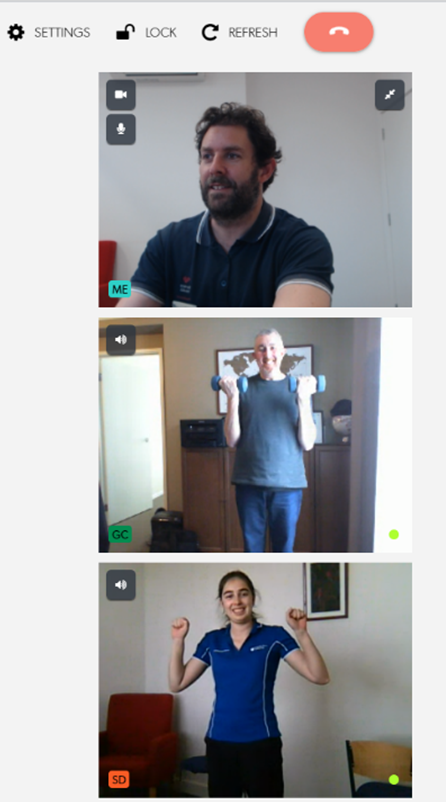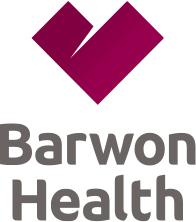Telehealth Awareness Month
October is Telehealth Awareness Month, and it is the perfect time to acknowledge the tremendous efforts of our community in embracing this virtual model of care.
Thanks to telehealth, Barwon Health is able to provide safe, personal, effective and connected care, without patients having to leave their home or community.
This year, the impact of COVID-19 led to a significant increase in the number of clinics and clinicians using telehealth to provide ongoing access to care for our consumers. Some of the clinical areas new to telehealth include specialist outpatient services delivered by paediatric outpatients and Barwon North Child and Family Services. Allied health services delivering telehealth include physiotherapy, audiology, hand therapy and speech therapy. Rehabilitation, indigenous health services, primary care, cancer services, diabetes referral centre, dietetics, aged care services and palliative care are also departments providing telehealth clinics for consumers.
One of the main objectives has been to develop staff skills and knowledge to embed telehealth access to provide ongoing consumer-centred care across all areas.
Fun facts
Telehealth consultations has eliminated the need for patient travel; reducing time, money and fuel spent attending appointments. So far this year telehealth has reduced carbon emissions by a staggering 96,654kg (CO2 calculated at 0.146Kg/Km and calculated using a standard sedan vehicle @ 6L/100km)

Telehealth video call appointments have increased each year, but rapidly in the pandemic:
2016-17: 235 consultations
2017-18: 462
2018-19: 914
2019-2020: 4613
Since 1 July 2020: 7354
How has telehealth helped
Greg Coombes, physiotherapy exercise client
What has been your experience using telehealth?
I had not used telehealth until these past few months. Due to COVID-19, I transitioned from face-to-face sessions at the Sunrise Centre to doing telehealth twice per week, with 15 to 20 sessions at least. It’s easy to use.
How did telehealth help you access health care?
I suppose the answer to that is that it’s easy to use if you have a device and can log in. With COVID-19 arriving, it has been great to find we have this alternative to healthcare. In our condition, not needing to travel from the comfort of our own home has been terrific.
What opportunities do you see for improving and expanding telehealth?
I’ve had a chat to my GP and he suggested to do appointments through telehealth as well. I’ve found that telehealth is quite widely spread and available throughout the health community, which is good. With limitations due to video streaming, we can only have four patients in each session. It would be better to have the ability to include more patients at once on the Health Direct platform. My physio, Matt, has two classes going at once so he can reach all his patients in a timely manner. An improvement would be enabling Matt to have more participants in each group, up to eight people. I got into physio via palliative care oncology. It’ s honestly been a godsend and maybe we should have been doing telehealth all along and hopefully it will continue into the future as a healthcare option for many.
Would you use telehealth again?
Yes, absolutely I would use it again. It seems to work on iPads, computers, mobile devices etc. I would absolutely say to anyone don’t fear it, as it makes life easier. I have been feeling safe and connected with healthcare support provided by telehealth whilst not being able to go anywhere due to COVID-19 and my low immunity. Not taking a risk going into hospital for exercise classes whilst having a high risk of infection due has been a big bonus. Telehealth has absolutely been better than the alternative - doing nothing during the COVID-19 pandemic.
Emma Breuer, Occupational Therapist Belmont CRC
How did you find providing care via telehealth to your consumers/patients at the start?
Initially, I felt anxious prior to telehealth appointments, particularly in relation to making the technology work (Having the right desktop, managing the hardware, supporting the client with accessing and troubleshooting)
What has been your ongoing experience using telehealth during COVID-19?
I find the vast majority of my individual telehealth appointments are successful, I have been able to demonstrate and observe exercises and equipment, build and use rapport with clients, and have difficult conversations when necessary. Health Direct is not as useful for group interventions.
What telehealth achievements would you like to acknowledge for your clinic, staff and consumers/patients?
Belmont CRC has had a group participant without internet access at home come into the centre, and be set up in her own room with a laptop, in order to participate in an online Memory Skills Group.
What are the benefits of telehealth for your clinic, for staff and for consumers/patients?
Reducing the burden of travel for clients has had benefits. The Oncology Rehab Program had a participant from the Otways, who stated he would not have been able to drive into Geelong twice weekly for the group. Upper limb exercises programs are easy to supervise and progress using the video and some clever positioning of the laptop to enable demonstration.
What opportunities are there for providing health care via technology (video, remote monitoring etc.) in the future? What would be beneficial for your clinic or clinical area?
I see an opportunity to increase the dosage of intervention in a less burdensome way for clients – eg once weekly in centre, once weekly via telehealth. Additionally, rehabilitation for people who live a long way away will be greatly enhanced by planning a mix of telehealth and face to face sessions.
Angela Brommeyer, Continuing Education Programs Lead – Allied Health / Clinical Education and Training
What telehealth achievements would you like to acknowledge for your clinic, staff and consumers/patients?
As with most teams within Barwon Health, the Clinical Education and Training team has had to be creative with how we continue to provide our service while minimising risk during the COVID-19 pandemic. Many education sessions have moved to video, with sessions run for groups of three or four through to over 100. Educators have embraced, upskilled and experimented in using videoconferencing platforms to deliver education. As clinicians have had to adapt and change their practice for it to be as effective via video, educators have had to adapt how they teach to the online environment. We haven’t been able to simply replicate what we would do face-to-face, as many courses relied on physical components. The Clinical Education and Training team have also supported the translation of some student clinical placements to telehealth, to continue to ensure that students can complete their placements where possible. These students have also gained invaluable telehealth skills, which many clinicians are just learning themselves.
What are the benefits of telehealth? For your clinic, for staff and for consumers/patients?
Videoconferencing has proved to have some additional benefits when used in education. One great thing is the geographical barrier that it removes. It has allowed us to deliver education to clinicians across Barwon Health sites without clinicians needing to travel. It has also given us the opportunity to share expertise and develop collaborative relationships with other organisations and clinicians across the Barwon South West region. Hopefully this will continue to improve care across the region. Other than the geographic benefits, the video platforms have proven to have some great tools for education. The opportunity to use the chat function to contribute or ask questions has allowed a different style of interaction. The whiteboard has facilitated some great collaboration between participants in training. The breakout rooms have allowed larger groups to easily split into smaller ones to discuss or work together on a task. Embracing these types of functions have allowed us to be creative with our education delivery, to ensure that clinicians are continuing to receive a high standard of education. The delivery of education via video platforms has also allowed clinicians to gain skills and confidence in using such platforms for the delivery of client care. The creativity and skills that have been gained during this time will be beneficial for Barwon Health staff and consumers, even once more face-to-face education is able to resume.
Grace Barillia, Paediatric Occupational Therapist, Barwon North Child & Family Services
How did you find providing care via telehealth (especially video) to your consumers/patients at the start?
I initially had reservations regarding the move to telehealth and the impact it may have had on families’ engagement, particularly as I was new to Barwon Health and we are a new service in the Child and Family Services Team. It has been simple to use right from the very beginning, and now we clinicians feel super confident when using telehealth.
What has been your ongoing experience using telehealth (especially video) during COVID-19?
It has been a positive experience supporting families via telehealth, as I have had the pleasure of building rapport, meeting other members of the family, and working within their “natural environment”. Telehealth has been simple to use for both the consumers and myself and supports consumers to stay safe at home and ensures that families can access care during these unprecedented times.
What telehealth achievements would you like to acknowledge for your clinic, staff and consumers/patients?
In starting a new service in the midst of a pandemic, it has been great to see the positivity shown towards the use of telehealth. It has allowed us to work together in a collaborative and connected way which has helped form interdisciplinary working relationships.
What are the benefits of telehealth (particularly video)? For your clinic, for staff and for consumers/patients?
There have been many benefits associated with telehealth, families feel safe as there is no risk of disease transmission, and it has been convenient for families to access telehealth at different times in the day, without the need for travel or babysitting for other siblings. Families have attended sessions and our service has noticed a consistency in attendance.
What opportunities are there for providing health care via technology (video, remote monitoring etc.) in the future? What would be beneficial for your clinic or clinical area?
For the near future, utilising telehealth as a tool to triage and prioritise clients will be effective for our service. It is a quick and easy way for families to connect with health professionals from their own home – this in turn reduces congestion in clinic, cleaning/preparation. It is also an option for people who may simply prefer service delivery in this way or when checking in or using a coaching approach.
Filter by tags
- University Hospital Geelong
- barwon health
- Emergency Department
- Geelong
- mental health
- research
- Deakin University
- funding
- community
- cancer
- careers
- Barwon Health North
- Andrew Love Cancer Centre
- surgery
- Norlane
- Northern Suburbs
- safety
- McKellar Centre
- heart
- Advance Care Planning
- women's health
- rehabilitation
- jobs
- kidney
- awards
